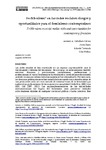Mostrar o rexistro simple do ítem
Fe-MI-nismo en las redes sociales: riesgos y oportunidades para el feminismo contemporáneo
| dc.contributor.author | Caballero-Galvez, Antonio A. | |
| dc.contributor.author | Zaera, Anna | |
| dc.contributor.author | Tortajada, Iolanda | |
| dc.contributor.author | Willem, Cilia | |
| dc.date.accessioned | 2022-11-14T15:03:26Z | |
| dc.date.available | 2022-11-14T15:03:26Z | |
| dc.date.issued | 2022-07-20 | |
| dc.identifier.citation | Caballero-Gálvez, Antonio A.; Zaera, Anna; Tortajada, Iolanda y Willem, Cilia (2022). Fe-MI-nismo en las redes sociales: riesgos y oportunidades para el feminismo contemporáneoAtlánticas. Revista Internacional de Estudios Feministas, 7(1), 62-87. Doi: https://dx.doi.org/10.17979/arief.2022.7.1.7049 | es_ES |
| dc.identifier.issn | 2530-2736 | |
| dc.identifier.uri | http://hdl.handle.net/2183/32022 | |
| dc.description.abstract | [Resumen] Las redes sociales se han convertido en un espacio imprescindible para la visibilización y defensa del feminismo. Sin embargo, en estos entornos también conviven discursos y producciones profeministas, posfeministas y antifeministas. Si bien el feminismo se ha fortalecido a través de las redes sociales, también los ataques online contra las mujeres se han intensificado. Por otra parte, los discursos posfeministas se han consolidado actuando como distribuidoras de una producción cada vez más variada de construcciones de la feminidad que exaltan el empoderamiento de las mujeres y su sexualidad (McRobbie, 2009; Lotz 2001; Gill 2007, 2011). Las autorrepresentaciones de las feminidades instrumentalizan los logros del feminismo para promover actitudes individualistas alejadas de cualquier identidad política o lucha colectiva. Este ensayo con algunos ejemplos ilustrativos pretende explicar las interacciones entre las prácticas feministas en las redes sociales, incluyendo el ciberfeminismo y la construcción de contrapúblicos, con el objetivo de captar la complejidad e implicaciones de todas ellas. | es_ES |
| dc.description.abstract | [Abstact] Social media have become a key online space for the visibility of feminist issues. However, on many of these platforms profeministic discourses and productions coexist with post-femininist and anti-femininist ones. While feminism has been strengthened thanks to social media, online attacks on women have also increased in number and intensity. Post-femininist discourses have established their role as distributors of an increasingly varied production of femininity constructs that exalt women's empowerment and sexuality (McRobbie, 2009; Lotz 2001; Gill 2007, 2011). Self-representations of femininities instrumentalize the achievements of the feminism movement by promoting individualistic attitudes far from any political identity or collective struggle. This essay with some illustrative examples aims to explain the interactions between different feminist practices on social media, including cyberfeminism and the construction of counterpublics, with the aim of capturing the complexity and implications of all of them. | es_ES |
| dc.language.iso | spa | es_ES |
| dc.publisher | Universidade da Coruña | es_ES |
| dc.relation.uri | https://doi.org/10.17979/arief.2022.7.1.7049 | es_ES |
| dc.rights.uri | http://creativecommons.org/licenses/by-nc-sa/4.0 | |
| dc.subject | Feminismo | es_ES |
| dc.subject | Posfeminismo | es_ES |
| dc.subject | Redes sociales | es_ES |
| dc.subject | Ciberfeminismo | es_ES |
| dc.subject | Contrapúblicos | es_ES |
| dc.subject | Feminism | es_ES |
| dc.subject | Post-feminism | es_ES |
| dc.subject | Social media | es_ES |
| dc.subject | Cyberfeminism | es_ES |
| dc.subject | Counterpublics | es_ES |
| dc.title | Fe-MI-nismo en las redes sociales: riesgos y oportunidades para el feminismo contemporáneo | es_ES |
| dc.title.alternative | Fe-Me-nism on social media: risks and opportunities for contemporary feminism | es_ES |
| dc.type | info:eu-repo/semantics/article | es_ES |
| dc.rights.access | info:eu-repo/semantics/openAccess | es_ES |
| dc.date.updated | 2022-10-26T17:50:26Z | |
| UDC.journalTitle | Atlánticas. Revista Internacional de Estudios Feministas | es_ES |
| UDC.volume | Vol. 7 | es_ES |
| UDC.issue | Núm. 1 | es_ES |
| UDC.startPage | 62 | es_ES |
| UDC.endPage | 87 | es_ES |
Ficheiros no ítem
Este ítem aparece na(s) seguinte(s) colección(s)
-
REV - ATLÁNTICAS - Vol. 07, 2022 [14]
Número monográfico: Estudios feministas de comunicación. Nuevos retos y escenarios.






